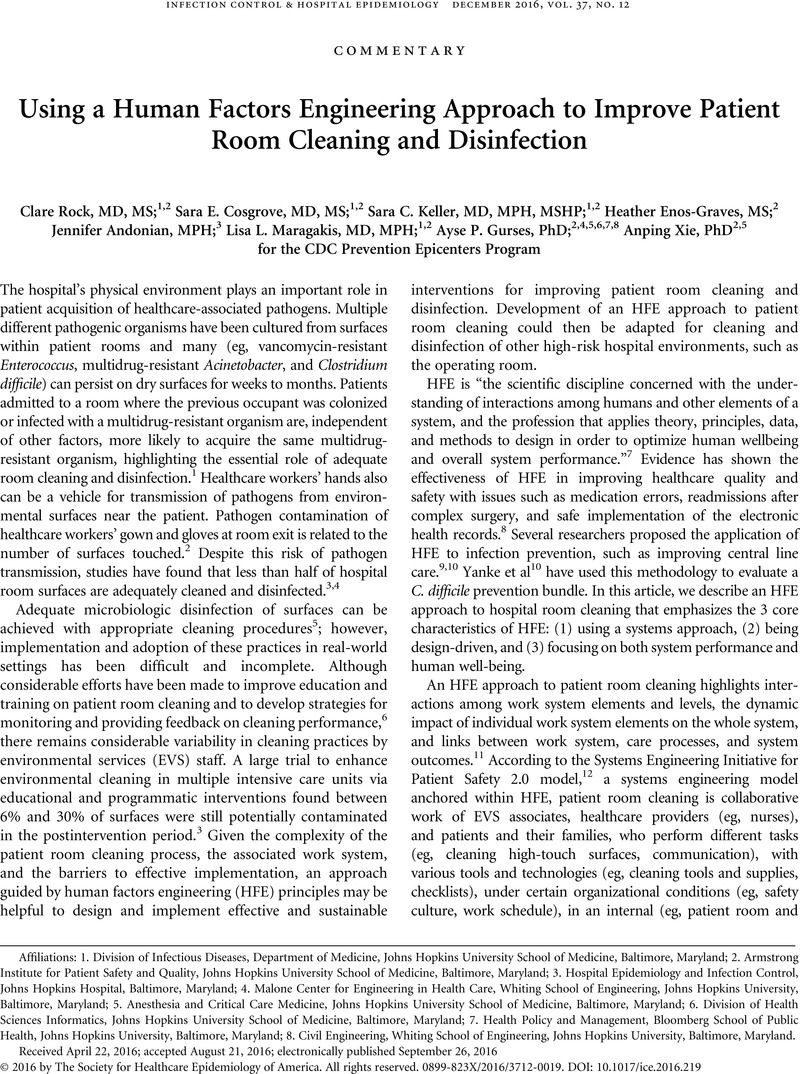Crossref Citations
This article has been cited by the following publications. This list is generated based on data provided by Crossref.
Fisher, Ann
and
Dembry, Louise M.
2017.
Norovirus and Clostridium difficile outbreaks: squelching the wildfire.
Current Opinion in Infectious Diseases,
Vol. 30,
Issue. 4,
p.
440.
Patel, Priti R.
and
Kallen, Alexander J.
2018.
Human Factors and Systems Engineering: The Future of Infection Prevention?.
Infection Control & Hospital Epidemiology,
Vol. 39,
Issue. 07,
p.
849.
Rock, Clare
Small, Bryce A.
and
Thom, Kerri A.
2018.
Innovative Methods of Hospital Disinfection in Prevention of Healthcare-Associated Infections.
Current Treatment Options in Infectious Diseases,
Vol. 10,
Issue. 1,
p.
65.
Xie, Anping
Rock, Clare
Hsu, Yea-Jen
Osei, Patience
Andonian, Jennifer
Scheeler, Verna
Keller, Sara C.
Cosgrove, Sara E.
and
Gurses, Ayse P.
2018.
Improving Daily Patient Room Cleaning: An Observational Study Using a Human Factors and Systems Engineering Approach.
IISE Transactions on Occupational Ergonomics and Human Factors,
Vol. 6,
Issue. 3-4,
p.
178.
Katz, Morgan Jane
and
Gurses, Ayse P
2019.
Infection prevention in long-term care: re-evaluating the system using a human factors engineering approach.
Infection Control & Hospital Epidemiology,
Vol. 40,
Issue. 1,
p.
95.
Gurses, Ayse P.
Dietz, Aaron S.
Nowakowski, Elaine
Andonian, Jennifer
Schiffhauer, Maggie
Billman, Carrie
Abashian, Anya M.
Trexler, Polly
Osei, Patience
Benishek, Lauren E.
Xie, Anping
Pronovost, Peter
Rosen, Michael A.
and
Maragakis, Lisa L.
2019.
Human factors–based risk analysis to improve the safety of doffing enhanced personal protective equipment.
Infection Control & Hospital Epidemiology,
Vol. 40,
Issue. 2,
p.
178.
Rock, Clare
Small, Bryce A.
Hsu, Yea-Jen
Gurses, Ayse P.
Xie, Anping
Scheeler, Verna
Cummings, Stephanie
Trexler, Polly
Milstone, Aaron M.
Maragakis, Lisa L.
and
Cosgrove, Sara E.
2019.
Evaluating accuracy of sampling strategies for fluorescent gel monitoring of patient room cleaning.
Infection Control & Hospital Epidemiology,
Vol. 40,
Issue. 7,
p.
794.
Knobloch, Mary Jo
Thomas, Kevin V.
Musuuza, Jackson
and
Safdar, Nasia
2019.
Exploring leadership within a systems approach to reduce health care–associated infections: A scoping review of one work system model.
American Journal of Infection Control,
Vol. 47,
Issue. 6,
p.
633.
Santos, Sara Soares dos
Mendes, Isabel Amélia Costa
Godoy, Simone de
Rangel, Elaine Maria Leite
Souza, Mirella Castelhano
Queiroz, Artur Acelino Francisco Luz Nunes
Souza-Junior, Valtuir Duarte de
and
Ferreira, Maria Veronica Ferrarezi
2020.
Profile of environmental service managers and workers in Brazilian hospitals.
Applied Nursing Research,
Vol. 51,
Issue. ,
p.
151229.
Hung, I-Chen
Chang, Hao-Yuan
Cheng, Aristine
Chen, Mei-Wen
Chen, An-Chi
Ting, Ling
Lai, Yeur-Hur
Wang, Jann-Tay
Chen, Yee-Chun
and
Sheng, Wang-Huei
2020.
Implementation of human factors engineering approach to improve environmental cleaning and disinfection in a medical center.
Antimicrobial Resistance & Infection Control,
Vol. 9,
Issue. 1,
Katz, Morgan J.
Osei, Patience M.
Vignesh, Arjun
Montalvo, Andrea
Oresanwo, Ifeoluwa
and
Gurses, Ayse P.
2020.
Respiratory Practices in the Long-term Care Setting: A Human Factors–Based Risk Analysis.
Journal of the American Medical Directors Association,
Vol. 21,
Issue. 8,
p.
1134.
Gravina, Nicole
Nastasi, Jessica A.
Sleiman, Andressa A.
Matey, Nicholas
and
Simmons, Davis E.
2020.
Behavioral strategies for reducing disease transmission in the workplace.
Journal of Applied Behavior Analysis,
Vol. 53,
Issue. 4,
p.
1935.
Patrick, Amie
Hess, Olivia
Cooper, Kaila
Rock, Clare
Doll, Michelle
and
Bearman, Gonzalo
2020.
Daily Disinfection of the Hospital Room and Non-critical Items: Barriers and Practical Approaches.
Current Infectious Disease Reports,
Vol. 22,
Issue. 12,
Shenoy, Erica S.
and
Weber, David J.
2021.
Lessons learned in infection prevention for Ebola virus disease and the coronavirus disease 2019 (COVID-19) pandemic—Principles underlying prevention.
Infection Control & Hospital Epidemiology,
Vol. 42,
Issue. 4,
p.
457.
Assadian, O.
Harbarth, S.
Vos, M.
Knobloch, J.K.
Asensio, A.
and
Widmer, A.F.
2021.
Practical recommendations for routine cleaning and disinfection procedures in healthcare institutions: a narrative review.
Journal of Hospital Infection,
Vol. 113,
Issue. ,
p.
104.
Lydecker, Alison D.
Osei, Patience A.
Pineles, Lisa
Johnson, J. Kristie
Meisel, Jacquelyn
Stine, O. Colin
Magder, Laurence
Gurses, Ayse P.
Hebden, Joan
Oruc, Cagla
Mody, Lona
Jacobs Slifka, Kara
Stone, Nimalie D.
and
Roghmann, Mary-Claire
2021.
Targeted gown and glove use to prevent Staphylococcus aureus acquisition in community-based nursing homes: A pilot study.
Infection Control & Hospital Epidemiology,
Vol. 42,
Issue. 4,
p.
448.
Boyce, John M.
2021.
A review of wipes used to disinfect hard surfaces in health care facilities.
American Journal of Infection Control,
Vol. 49,
Issue. 1,
p.
104.
Parry, Michael F.
Sestovic, Merima
Renz, Christopher
Pangan, Abegail
Grant, Brenda
and
Shah, Asha K.
2022.
Environmental cleaning and disinfection: Sustaining changed practice and improving quality in the community hospital.
Antimicrobial Stewardship and Healthcare Epidemiology,
Vol. 2,
Issue. 1,
Lu, Yuqian
Bishop, Naomi B.
and
Zadeh, Rana
2022.
Lean Design of the Pediatric Intensive Care Unit Patient Room for Efficient and Safe Care Delivery.
HERD: Health Environments Research & Design Journal,
Vol. 15,
Issue. 4,
p.
369.
Warren, Bobby G.
Barrett, Aaron
Graves, Amanda
King, Carly
Turner, Nicholas A.
and
Anderson, Deverick J.
2022.
An Enhanced Strategy for Daily Disinfection in Acute Care Hospital Rooms.
JAMA Network Open,
Vol. 5,
Issue. 11,
p.
e2242131.





